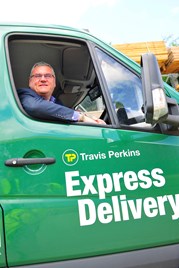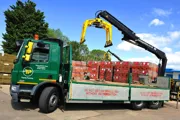Acquiring vehicles and disposing of them at the end of their fleet life is easy – it’s the bit in the middle that is critical.
That’s the view of Graham Bellman, group fleet director of Northampton-headquartered Travis Perkins plc, which operates 4,000 commercial vehicles as well as 2,500 company cars and 4,000 mobile items of plant equipment.
But Bellman, who marks 15 years with Travis Perkins this year, having joined the high-profile business as a fleet engineer, says: “We are doing nothing radical, just what is industry best practice. We need to ensure a complicated fleet continually operates as cost-effectively as possible.”
Data, says Bellman, is critical for today’s fleet decision-makers and at Travis Perkins he has almost as many analysts as fleet engineers. However, he adds pointedly: “You can have all the data in the world, but understanding it and using it to your advantage to improve compliance and reduce costs is what’s essential.
Travis Perkins factfile
Company: Travis Perkins plc
Group fleet director: Graham Bellman
Time with business: 15 years
Company cars: 2,500
Commercial vehicles: 4,000
Operating cycle: Four years (trucking fleet), eight-10 years (remainder of commercial fleet)
Funding: Lease and outright purchase.
“Capturing data and not using it is criminal. We measure everything and use a lot of data in many areas of fleet operations. But I like to focus on road safety and specifically a driver’s right foot because then everything else falls into line: speeding, harsh acceleration and braking, fuel economy, carbon footprint reduction etc.”
Travis Perkins, which currently operates 19 businesses across the UK and employs more than 26,000 people, is best known for brands such as Wickes, BSS Industrial, Toolstation, Benchmarx and Tile Giant, as well as Travis Perkins itself, and there cannot be anyone who has not seen the ubiquitous green and gold HGVs delivering building supplies nationwide.
The business is set to expand over the next four years – and that will mean an even larger fleet – following the recent announcement that the UK’s largest distributor of building materials to trade and retail customers is to create 4,000 new jobs, supporting 400 new branches and stores across the country.
Travis Perkins operates from more than 2,000 branches nationwide across all its businesses and the commercial vehicle fleet encompasses virtually every type of vehicle imaginable, from 3.5-tonne panel vans, pick-ups and flatbeds clocking up an average 35,000 miles a year to 44-tonne artic trucks, as well as trailers and many units fitted with tail-lifts and cranes.
The majority of vehicles are branch or store-based – 45% of branches in its merchanting businesses have just one vehicle – with 400 trunking HGVs delivering stock to branches and stores averaging 135,000 miles a year. Additionally, Travis Perkins uses logistics specialist DHL as a third-party provider operating about 150 vehicles and 80 tractor units to supplement its own delivery fleet in outlying areas.
“Capturing data and not using it is criminal – we measure everything and use a lot of data in many areas of fleet operations”
Graham Bellman, Travis Perkins
Collectively, the organisation’s commercial vehicle fleet clocks up around 150 million miles a year, with the company’s annual fuel spend amounting to a colossal £30 million, highlighting the fact that the slightest saving delivers significant financial rewards.
Business expansion means that in the past 12-18 months 150 new tractor units have been added to the company’s fleet and 250 new trailers to support growth. While further corporate expansion is clearly welcomed, it delivers further day-to-day operational challenges to Bellman and his 50+-strong fleet team and support staff, which are based centrally in Northampton and in divisional units.
Bellman, who holds responsibility for vehicle procurement, compliance and administration, including managing maintenance budgets based on a cost per vehicle per month billed to individual operating locations, explains: “Safety is at the top of the agenda and engineering out the risks faced, whether on the road or in the loading and unloading and handling of goods ranging from a bag of nails to a pallet of bricks, is critical.”
While accident ratio across the organisation is low, the biggest causation factor is property damage as vehicles make their way along country lanes and up and down driveways delivering goods to private properties.
He continues: “Operational efficiency and compliance are constantly changing. Four thousand vehicles is a lot and the fleet is expanding, but they are based in 2,000 locations and that figure will also rise, making the whole operation a challenge.
“Making sure every vehicle is compliant, and every branch undertakes daily checks and ensures inspections and service, maintenance and repair procedures are adhered to, are issues that constantly challenge us because we want to get it right.
“That’s why data is so important – because it influences driver behaviour and maintenance regimes and can be used to reduce accidents. Things happen to vehicles, but if we have data then we have the information available to be able to educate drivers and managers and that assists in keeping service, maintenance and repair costs to a minimum.”
Bellman joined Travis Perkins from TNT, having spent 15 years rising through the ranks from mechanic to sales manager. Just five years ago, he admits he saw little value in piloting in-vehicle telemetry in 30 trucks.
“We knew where our trucks were and we knew where they were going,” says Bellman. He now confesses to being a technology enthusiast, having equipped the entire commercial vehicle fleet with telematics and taken millions of pounds’ worth of costs out of the business, as well as overseeing a massive improvement in operating efficiency.
Travis Perkins cut 400 vehicles with improved utilisation
Initially focused on reducing vehicle idling and improving fleet utilisations, the savings delivered as a result of real-time information generated by the technology make astonishing reading:
- Almost 400 vehicles cut from the commercial vehicle fleet – virtually all trucks – as a consequence of improved vehicle utilisation delivering operating cost savings of more than £50,000 per year per HGV removed.
- A 70% daily reduction in vehicle idling – the average vehicle spent more than 100 minutes per day idling, ‘wasting’ up to three litres of diesel.
- A 12.6% reduction in vehicle accident costs as a consequence of managing vehicle speed and monitoring drivers’ behind-the-wheel behaviour.
- Major fuel savings – and consequently emission savings – as a result of improved journey route planning and scheduling and employees adopting a smoother driving style.
- Significantly faster vehicle loading and unloading turnaround time – the commercial fleet of Travis Perkins is now running at 93% utilisation per day, up from 60%.
There have also been a range of other added-value benefits, including daily defect reporting, axle weighing, a crackdown on fuel and product theft and a near-50% reduction in speeding offences, as well as improvements in productivity.
“Travis Perkins quantifies the savings made in terms of how many additional bags of sand the company would have to sell”
Bellman talks of the “language of profit”, with Travis Perkins quantifying the savings made in terms of how many additional bags of sand the company would have to sell if it was not cutting costs through the use of telemetry.
He says: “The cost of the system was paid for by the fuel savings we have made. Everything else has been a bonus and delivered savings totalling millions of pounds year-on-year to the company’s bottom line. It’s important that fleet decision-makers embrace technology – I’ve proved that, having been a sceptic.”
He continues: “We worked very hard with our communications and HR teams to communicate with drivers. We made telematics relevant to them by explaining how much extra we would have to sell in terms of sand and other products to recoup the money we were ‘wasting’. The numbers were frighteningly high and it made drivers take note.”
The team of data analysts study the information sent from the black boxes that are linked to each commercial vehicle’s engine control unit. They then compile reports for branch and store managers and regional directors, as well as the transport team.
Electronic-based vehicle checks
The wealth of data available to the company is now increasing, with the recent introduction of electronic user delivery systems that embrace first driver vehicle checks. They have replaced a paper-based questionnaire, with checks tailored to each vehicle rather than being generic, and giving the ability to message drivers individually.
“We have some great drivers, but we need to have an audit trail that checks are being undertaken. An electronic system further enhances our procedures,” says Bellman.
Travis Perkins was one of the founder members of the Fleet Operator Recognition Scheme (FORS) – initially launched as the Freight Operator Recognition Scheme in London but now rolled out nationally – and is also a member of the Freight Transport Association’s Van Excellence programme and CLOCS (Construction, Logistics and Cyclist Safety), which was spun out of a Transport for London-commissioned report into road safety.
 Bellman, who has overseen Travis Perkins becoming one of the few gold-accredited FORS members, says: “Involvement with those organisations is one of the things we are most passionate about. Commercial vehicle drivers do not have the best profile in the UK and it is essential that we make sure people are safe and competent to do their job.
Bellman, who has overseen Travis Perkins becoming one of the few gold-accredited FORS members, says: “Involvement with those organisations is one of the things we are most passionate about. Commercial vehicle drivers do not have the best profile in the UK and it is essential that we make sure people are safe and competent to do their job.
“It is not just about driving, it is about loading and unloading vehicles, operating cranes and tail-lifts and making sure we do our best to protect the public and other road users when going about our work.”
Joining such organisations and conforming to their best practice recommendations has also proved to be business enhancing for the company.
One of Travis Perkins’ largest customers gave all its contractors three months to meet the CLOCS standard or they would lose the right to tender for work and enter its construction sites. Bellman calculates that would have put £60 million of income per year at risk.
“I would encourage all companies that operate commercial vehicles to join these organisations. They promote sensible policies and procedures for all businesses, not just those in the construction and haulage industries,” he says.
Sharing operating best practice is essential, according to Bellman, which is why he became a founder member of the Fleet Industry Advisory Group (FIAG).
“Travis Perkins has synergies with a lot of other businesses and FIAG, along with FORS, CLOCS and Van Excellence, provides a platform for sharing knowledge, problems and initiatives,” he says.
“Anything we can do to make our roads safer and transport operations more efficient has got to be good. Big companies like Travis Perkins should be involved, but so should smaller companies with only a handful of vehicles. As fleet decision-makers, we should never stop learning and seeking to improve the operations we run.”
Further underlining its risk management focus, Travis Perkins won two awards in 2014 from road safety charity Brake, plus the Fleet Van fleet of the year, construction and building.
Currently employing 15 driver assessors, Travis Perkins is looking to add another four this year, while also having in place the full range of
checks on driving licences, endorsements, etc. Driver coaching and disciplinary procedures are in place, as are ‘carrots’, with a Driver of the Year event and cash bonuses for staff, as Travis Perkins reinvests financial savings by rewarding drivers.
The all-diesel vehicle fleet is set to be supplemented later this year by two biogas tractor units on a long-term trial.
 The company is paying for the conversion of the vehicles, which will be filled at a biogas pump located at junction 18 of the M1 close to its headquarters and key distribution facilities. Bellman calculates that investment of £20,000 per unit for the system will be returned through fuel savings within two years as each vehicle clocks up around 130,000 miles a year.
The company is paying for the conversion of the vehicles, which will be filled at a biogas pump located at junction 18 of the M1 close to its headquarters and key distribution facilities. Bellman calculates that investment of £20,000 per unit for the system will be returned through fuel savings within two years as each vehicle clocks up around 130,000 miles a year.
Travis Perkins has also looked at operating electric vans but, with light commercial vehicles averaging 35,000 miles a year, it remains to be convinced of the financial equation, while nevertheless acknowledging their environmental credentials.
Across the purchased LCV fleet, which operates to an eight-year replacement cycle, the Mercedes-Benz Sprinter is the vehicle of choice, supplemented by Ford Transits and a range of other manufacturers and models, as the group has expanded through acquisition and so has inherited vehicles.
Trucks on the trunking fleet are contract-hired on four-year leases, with trailers on 10-year replacement cycles, while trucks operating at a local level are purchased and operated over eight years. Vehicles are typically DAF, supplemented by Mercedes-Benz, Scania and Volvo models.
Vehicle maintenance is outsourced to 350 workshops across the UK and managed by a third party provider.
Bellman concludes: “It is vital that fleet managers are clear on what they want and understand what they require from vehicles and specification.
“You can always buy cheaper, but buying what’s right for the job is not always obvious.”
Author: John Charles






















Login to comment
Comments
No comments have been made yet.